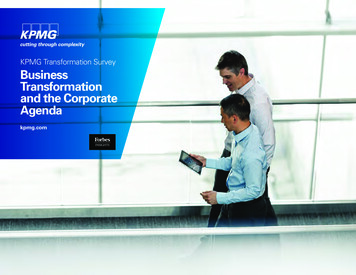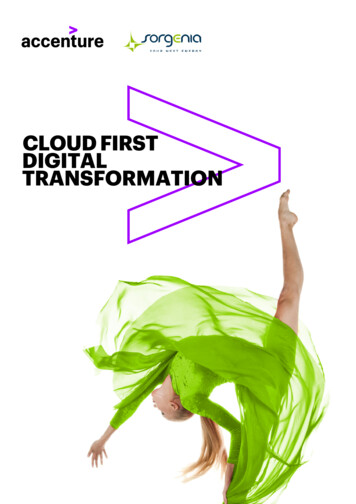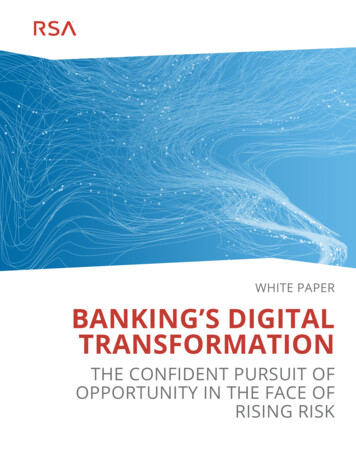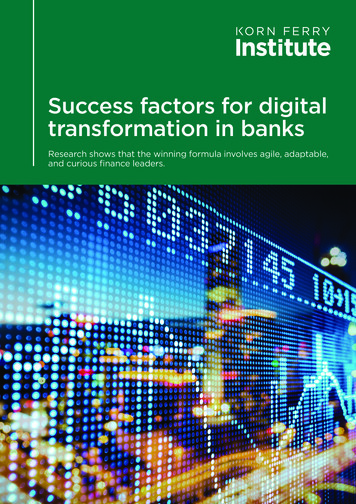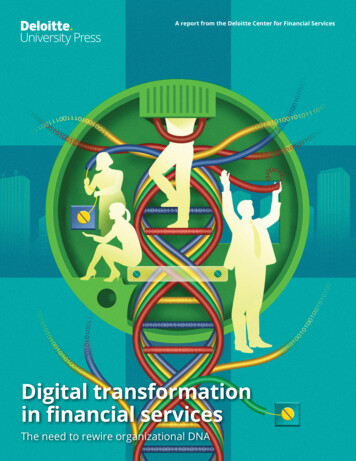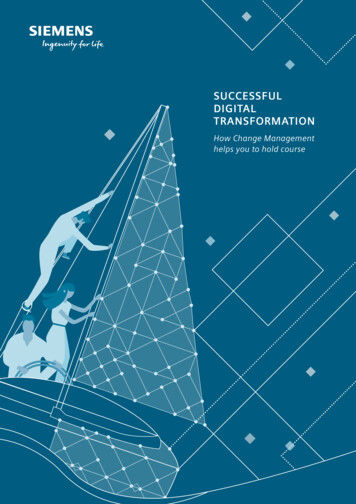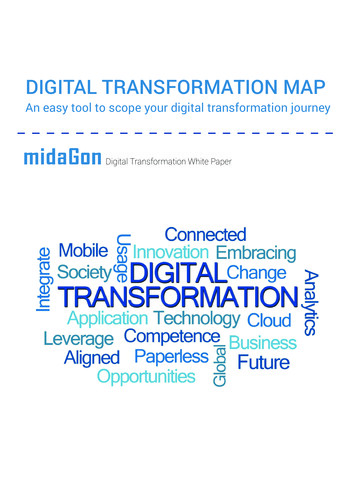
Transcription
DIGITAL TRANSFORMATION MAPAn easy tool to scope your digital transformation journeyDigital Transformation White Paper
ContentsWhat does digital transformation mean for you?4Introducing the digital transformation map4Using the digital transformation map6Enabling components for digital transformation7The deliverables of digital transformation8Conclusions 92Copyright Midagon Ltd 2018. All rights reserved.
What does digital transformationmean for you?and Midagon’s experience based on manycustomer cases. Every company must createthe definition of digital transformation for itself,Digital transformation is widely discussed and ispreferrably uswwing available definitions as aimpacting every company.reference. Your scope may include disruptivenew business models or it may be a businessNearly 2,600 CIOs surveyed by Gartner in 2016optimization change improving technicalsaid they devote 18 percent of their budgets tocapabilities at the customer interface. Accordingdigital transformation, a figure that is expectedto the Gartner 2017 CEO survey, 42 percent ofto increase to 28 percent by 2018. Accordingrespondents plan to use digitalization to optimizeto CIO.com (Oct.6, 2017) and Harvard Businessrather than transform their business.School, leading digital companies generate bettergross margins, better earnings and better netIt is also clear that the transformation scopeincome than organizations in the bottom quarterneeds to be maintained during the digital journey.of digital adopters. In USA, digital leaders postedFollowing the lean-agile principles, the overalla three-year average gross margin of 55 percent,scope must be revisited frequently in order tocompared to just 37 percent for digital laggards.capture the lessons learned, such as from thesmall practical pilots. The tool introduced in thisHowever, definitions and scoping on digitalpaper also serves this maintenance purpose.transformations are vague and manyorganisations struggle to agree on their mostfeasible scope. In order to understand theexpected business impact of a digital intensiveIntroducing the digital transformation maptransformation, it is important to define theSince digital transformation is a difficult topic tocontent and agree on the scope. When agreementunderstand, we need a simple, practical modelis reached, the outcome serves as a starting pointthat helps all of the parties to discuss the content.for more detailed plans.This paper introduces A Digital TransformationMap to facilitate collaboration around this majorThis paper introduces an approach that helps youchange. The key purpose is to provide you withto define the scope of digital transformation, or aa framework that helps to identify the high levelpart of it, for your environment. The definition andbuilding blocks that are most often impactedscoping is needed in many moments of the digitalduring a digital transformation journey. The topjourney, such as when agreeing on strategiclevel structure is introduced in Figure 1.roadmaps, architecture design and project scope.The main business concern we are tacklingIn this article, we use digital transformationincludes questions such as what is digitaldefinitions that are typically available in thetransformation? What components are included?standards, articles and industry practices. TheWhat is the scope of the change? What areoverall content is based on industrial frameworksthe benefits? What are the next small pilot3Copyright Midagon Ltd 2018. All rights reserved.
Figure 1. Top level structure of the Digital Transformation Mapimplementations that we should test? The specificshould be enabled. An idea and innovationconcerns vary, depending on the role that youpipeline should be established. A new producthave.introduction process must also include also digitaldevelopment and the actual changes are to beThe Board of Directors must approve the strategicdriven forward in modern agile project mode.direction and need to understand the scopeand risks of digital transformation. LeadershipLine managers need to understand how theteams may want to select strategic focus areas,organisation and roles, rights and responsibilitiesunderstand the components included, ensure theare tuned to enable the change. Because of theright parties are involved and grant the right levelmagnitude of change, we can expect that theof funding.corporate culture is facing changes, the attitudesof individuals may be challenged and a new set ofProduct management, marketing, sales andskills may be required in the new digital intensivelines of businesses need to understand the newenvironment. It is also expected that there will bebusiness model opportunities and how it shouldlack of competent people, motivating companiesimpact customer experience.to introduce strong employer branding efforts.In order to reach a fast moving development andProduct, process and digital development teamsoperational cycle, a Lean-Agile way of workingmust understand the technical structure and4Copyright Midagon Ltd 2018. All rights reserved.
how the technical solutions are developed in anagile manner. Because the launched solution isused all the time, the teams must agree how thedevelopment effort is handed over to runningservices and how continuous operations take place.The digital services must be running in sync withthe physical world. The services are implemented,for example, in factory lines or in car tyres and theyare accessed by people on the move.Using the digital transformationmapIt is clear that a digital transformation is a majorchange in any company. The digital transformationFigure 2. Sample moments to use the mapmap demystifies the necessary components andguides you in identifying the most feasible priorityitems. You can use the map to describe the overallfield service. Or you need to scope a new businesstransformation architecture in a simple way from aidea or a program. If you face an organisation-widefunctional perspective.challenge, you may need to handle it in smallerportions. In that case, the solution space withinThis tool can be used to bridge stakeholder viewsthe map can be first categorised, analysed andand opinions. This is illustrated in the momentsprioritised using business capability analysis.that are described in Figure 2.Within boundaries of the selected problem area, youYour starting point or primary viewpoint is alsoshould then start the scoping and fit/gap analysiscase dependent. If you have a strategic viewpoint,for each of the components. You can use thestart the discussion from the top and alsofollowing easy questions for each element:consider other components. If you start fromlocal implementations, start from the bottom andconsider the feasibility of the management layersabove. The map also communicates clearly that thechange includes the major technical componentsbut all the other aspects must also be considered.First, select your overall business problem area.The area may be a digital agenda for a wholeorganisation, a value stream, or product family. Oryour digital gap may be in a a capability area, like Is this element relevant for my case? If not,select the next element. What is the (digital intensive) target state? What is the (digital intensive) current state? Is there a fit or how big is the gap that wehave? What are the major business benefit driversfor the changeDo you see major risks? What are the potential changes that we shouldimplement to realize the benefits and mitigatethe risks?5Copyright Midagon Ltd 2018. All rights reserved.
After this quick exercise, you have a very strongstart a concrete pilot with one of the identifiedunderstanding of the magnitude of changepriority items, use the findings for detailedyou are facing. If the analysis is done togetherprogram planning, or trigger next steps in thewith stakeholders, there is also a commonMidagon Innovation Wagon – process.understanding about the needed steps and a goodinput for next planning steps.The digital transformation map is an easy toolEnabling components for digitaltransformationto highlight focus areas and to ensure that theAll companies introducing digital services shouldbig picture is communicated, balancing all of themake sure that there is enough support for thedefault viewpoints.first innovations, core technical implementationsand end users. Because digital transformationIf the top level map is too generic for your purposemay introduce major changes in any company,or you need more details, each module in themany organisational capabilities must be checkedoverall map can be defined in more detail. Thedwuring the journey.default detailed components are described inFigure 3 Digital transformation components. OneThe components at the top of the map ensure thatmay want to tune his/her own scoping as feasiblethe digital transformation is linked to the companyin the target environment.strategy and that the overall transformation hasan agreed direction. The company governanceAfter using the digital transformation map atmodel must include digital agenda items andthe level fitting your business problem, youleadership style should be digital friendly. In orderhave a good picture of the scope of your digitalto understand the business environment, thetransformation challenge. The next step may bevalue chain, network or digital related ecosystemsto complete a strategic communication package,should be defined in order to provide the contextFigure 3. Digital transformation components6Copyright Midagon Ltd 2018. All rights reserved.
for more detailed development.A lean-agile leadership style is a good way toThe deliverables of digitaltransformationenable digitalization. Digital innovation, agileIn many cases, it is expected that digitalizationportfolio, project and solution developmentincludes the introduction of new business models.practices belong to your core transformationAt a minimum, we should improve the customertoolbox.facing experiences. For this purpose, businessmodel development can be advanced, for example,The Midagon Innnovation Wagon (MIG) is ausing the Lean Canvas – approach. The businessframework that is used for identifying, prioritizingcontext can be described using value networkand implementing digitalization initiatives. Theand value streams, tools that are familiar fromMIG approach is well-fitted to the purpose ofthe Lean – world. Service design and customerLean-agile leadership. For example, the ideajourney tools can be used to define targets for theand innovation pipeline should be established,customer experience.the new product introduction process mustinclude also digital development and the actualYour own needs drive the starting pointchanges should be driven forward in the modernand overall scope of the technical solutionagile project mode. Midagon also has gooddevelopment. The technical components of thepractices for managing business value andmap include a default enterprise architecture.benefit realization, and program and projectThe stack from right to left includes businessmanagement.process flows and roles, digital workplaces for theroles, information to be handled, applications toNon-functional capabilities like architecture,handle the information, data networks to accessfinancial management and information securityinformation and computing environments to hostmust also be made compliant to digital businessall of the needed digital elements.needs. Supplier management for digitalcapabilities may include many changes comparedThe same stack from the bottom-up includesto the current situation and includes, for example,location dependent differences. At the bottom,new digital oriented supplier and technologythere is physical space, physical flow andselections.physical systems, such as factory floors andwalls, car tyres or a mechanical engine. TheDigital changes in a company are often so majornext layer includes physical – digital interfacesthat cultural change even needs to take place. Atsuch as sensors, smart machines like robotsa minimum, organisational structures, roles andand the local digital control tools located nextcompetence levels must be revisited. Typical toolsto the actual devices. At close proximity, edgefor these areas can be found in the operationalcomputing capacity needs to be managed,modeling – space together with the company HRdata communication must be in place, the- team.digital workplace must be fitted to the physicalenvironment and the team and individual workflowneeds to be optimised. This layer has traditionally7Copyright Midagon Ltd 2018. All rights reserved.
belonged to the area of operational technology orConclusionscustomer technology and processes are improvedwithin a local factory or team.The digital transformation map is a scoping andcollaboration tool that helps organisations toOne level up, all information is already availableincrease discussion, awareness and opportunitiesin digital format and the location of activities canin order to succeed in their digital journey. Itbe chosen more flexibly. The location may besimplifies a complex world of digital development,a control room in a factory, at a site in the nextby ensuring that all parties can discuss thisbuilding or even further away. A key purpose isimportant topic. The map is a standalone tool.to control the target physical tier remotely, forHowever, it is also compliant with relevant, relatedmonitoring and perhaps even tuning purposes.industry practices.Process flows, roles, workplaces, information,applications, networks and computing mustThe map is compatible with the major industrialbe organised for this need. Traditionally, thisstandards, bridging approaches across manylayer includes components from operationaldisciplines. Therefore, it is also future proof. Thetechnologies (OT) and information andkey sources in the technical area are Industrialcommunication technologies (ICT). The processInternet Consortium (IIRA 1.8) and Industrie 4.0,improvement may take
This paper introduces A Digital Transformation Map to facilitate collaboration around this major change. The key purpose is to provide you with a framework that helps to identify the high level building blocks that are most often impacted during a digital transformation journey.
